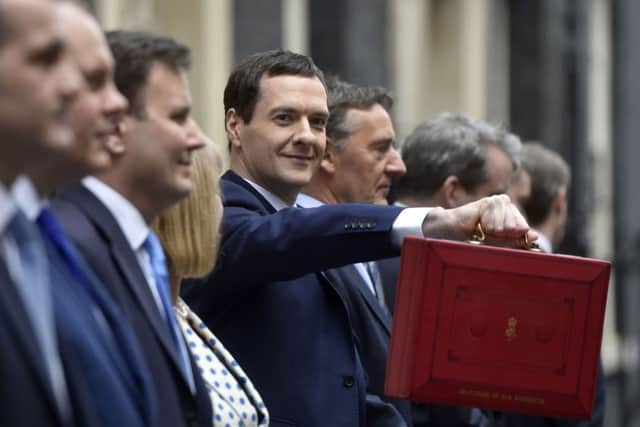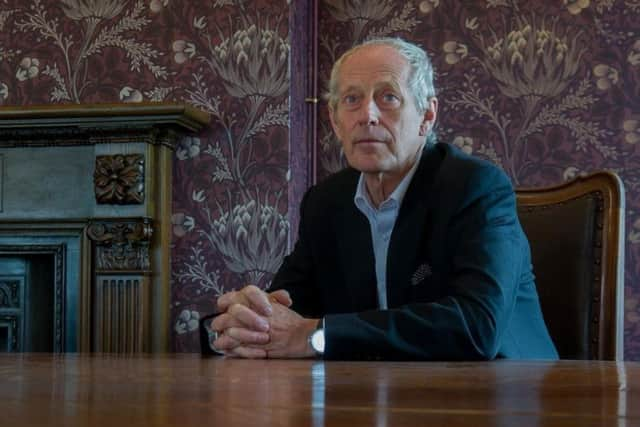On a cliff edge: How Yorkshire's councils, police and NHS have been hit by age of austerity
and live on Freeview channel 276
When the coalition Government was formed in 2010, Chancellor George Osborne described how it had “inherited one of the most challenging fiscal positions in the world”. Britain’s deficit was the largest in its peacetime history and the state was borrowing £1 for every four it spent.
“From 2001 onwards, public spending grew steadily as a share of the economy and a structural budget deficit began to emerge,” Osborne’s 2010 Spending Review stated after the Conservatives and Liberal Democrats came to power in May that year. “Government measures to tackle this structural deficit did not begin to take effect until 2010, by which time the impact of the financial crisis had made an unaffordable situation unsustainable.”
Advertisement
Hide AdAdvertisement
Hide AdOsborne’s review set out how the Conservative-Liberal Democrat coalition, under Prime Minister David Cameron, would carry out the nation’s “unavoidable deficit reduction plan”. The aim, he said, to “secure economic stability at a time of continuing uncertainty in the global economy and put Britain’s public services and welfare system on a sustainable long-term footing”.


Cuts to public spending were a
core part of that plan, with departmental budgets, aside from health and overseas aid, initially facing reductions averaging 19 per cent over four years. The age of austerity was under way.
Eight years on, local authorities are now “facing a cliff edge”, it is being warned.
According to the Local Government Association, by 2020 local authorities will have seen their core Government funding reduced by nearly £16bn since 2010. “Councils will have lost 60 pence out of every £1 the Government had provided to spend on local services,” the body has explained.


Advertisement
Hide AdAdvertisement
Hide AdLGA analysis estimates councils in England face a funding gap of £7.8bn by 2025 and plugging the hole would only keep services standing still, not cover any improvements. The body said the Government’s next spending review would be “make or break” for the local services that are facing huge demand and funding pressures. In July, troubled Northamptonshire County Council issued a notice for the second time this year confining spending to “only the most essential services” amid fears its budget shortfall could reach £70m this year.
“Councils are really facing a cliff edge,” says Coun Richard Watts, chair of the LGA’s Resources Board. He fears “councils will be put in impossible positions and more will go to the wall”.
Yorkshire council leader Coun Peter Box, who has fronted Labour-run Wakefield Council since 1998, says Northamptonshire “should be a stark warning to Government”. “If that authority can go under so can others, and what’s going to happen then?”
He says about 4,500 jobs were lost in Wakefield in the 12 months around the banking crash of 2008 – followed shortly afterwards by the introduction of the Government’s austerity programme. In his view, the cuts have been “too long” and “too deep”.


Advertisement
Hide AdAdvertisement
Hide Ad“You can’t just keep on cutting and expect that things are going to continue the same because they won’t,” he says. “Of course there was a challenge, but I think local government has risen and has coped remarkably well despite all the cuts but that cannot keep going on forever.”
Coun Ian Gillies, the Conservative leader of City of York Council, says there had to be a response to the financial crisis. “We were spending money that we didn’t have. The Government then had to pay the money back and everybody has suffered because of that.”
Police forces in Yorkshire have seen their numbers of frontline officers shrink as cuts have taken place to their budgets since 2010.
From the beginning of plans to reduce spending on public services, there were concerns that less money for policing would lead to fewer resources and diminished capacity, says Zuleika Payne, the outgoing chair of the South Yorkshire Police Federation. “Sadly, our fears have become the reality.”
Advertisement
Hide AdAdvertisement
Hide AdThe coalition Government’s Spending Review in 2010 set out plans for police resource funding to drop by 14 per cent in real terms by 2014-15. Savings, it said, would be made from efficiencies in IT, procurement and back office functions.
Eight years on, a report published last week by the National Audit Office (NAO) says the main way forces have managed financial pressure is by reducing the size of their workforces. It cites figures showing falls of 40 per cent, 21 per cent, and 15 per cent in the numbers of PCSOs, police staff and officers respectively between 2010 and 2018.
Overall funding to forces – a combination of central government grants and council tax – has fallen by 19 per cent in real terms since 2010-11, according to the spending watchdog.
“Police officers strive to deliver a gold plated service to members of the public,” says Zuleika. “But that has become increasingly difficult to do and now we feel that the cuts are too deep, too much and too drastic.”
Advertisement
Hide AdAdvertisement
Hide AdBudget cuts started with the coalition Government’s austerity programme, Sgt Craig Grandison, vice chairman of the West Yorkshire Police Federation, explains, and the force started to lose officers “very quickly”. “We have seen a massive reduction in officer numbers both locally and nationally. We have seen budgets slashed which I would say has led to a reduction in the number of officers available in frontline policing.”
With calls still coming in, staff have been faced with workload pressures. Sickness has crept up by around 2.5 per cent in the force in the past seven to eight years, he says, with sickness absence now hovering around the five per cent mark and much of it linked to stress and mental health.
It is only in the past year that officer numbers have begun to “crawl” back, he says. It is a similar picture in Humberside.
“We had such healthy numbers and then the budget is cut and all of a sudden we are losing officers hand over fist,” says Peter Musgrave, chair of the Humberside Police Federation. “You can make savings in any organisation but ultimately, if you are going to have to make such huge savings as was required, you have to do that through people.”
Advertisement
Hide AdAdvertisement
Hide AdRecruitment is now helping to put the force on an “upward trajectory”, he believes. “I’m pleased because we have 10 years of pretty horrendous times.”
A spokesman for the Home Office says that the department has provided “a strong and comprehensive settlement”, increasing total investment in the police system by over £460m in 2018/19, including increased funding for local policing through a council tax precept.
“The Home Secretary has also been clear that he is committed to making police funding a priority at the next Spending Review, which will set budgets for the longer term,” he says, “The Policing Minister has spoken to every police force in the country to understand the demands they are facing, and the Home Office is working with the police and across Government to put forward the evidence to ensure the police receive the resources they need.”
Since 2014, the Government has also committed support to welfare provision for policing, according to the department, including £7m for mental health charity Mind’s Blue Light Wellbeing scheme and £7.5m for the College of Policing to develop a National Police Welfare Service.
Advertisement
Hide AdAdvertisement
Hide AdThough health spending has increased in real terms since 2010, the NHS has not been without pressures, particularly given the country’s ageing population. “NHS funding has grown by slightly more than one per cent a year in real terms since 2009-10,” Professor Sir Chris Ham and Richard Murray of health charity The King’s Fund wrote in July. “This is well below the long-term average increase of 3.7 per cent a year.”
By the end of 2017-18, the impact of several years of slow funding growth had become clear, they argue. “A winter crisis in A&E, the depth and duration of which had not been seen for more than a decade, resulted in more people waiting to be diagnosed and treated and many others having their appointments for elective treatment cancelled.”
Leeds GP Dr Richard Vautrey says the response to the financial crisis “has been a major contributor to the GP recruitment and retention crisis”. Vautrey, who is chair of the British Medical Association’s GPs committee, says: “Insufficient funding going into general practice since 2008 has led to spiralling workload because of an insufficient workforce to cope with this, which in turn has put off younger doctors choosing GP as a career and been a factor leading to older doctors quitting.”
David Smith, chief executive of Hull and East Yorkshire Mind mental health charity, believes that “without doubt”, the response to the financial crisis has had a “detrimental impact” on the lives of “an untold number of people”. “The recession led to job losses that directly impacted on the core foundations of people’s mental health – their sense of purpose, their relationships and their security in a rapidly changing world. For some, these problems will have been transitory, for others they will have been devastating not only for the individuals themselves but also their family, friends and work colleagues. The longer-term impact of the crisis and austerity measures have led to some of the traditional sources of support people turned to when times were tough vanishing.”
Advertisement
Hide AdAdvertisement
Hide AdBut things could have been much worse, he says, with anti-stigma campaigns encouraging people to ask for help and investment in mental health from the Government contributing to support for most people being more widely available than it was 10 years ago.
Earlier this year, Prime Minister Theresa May announced that the NHS would receive an extra £20bn per year more than it currently does by 2023-24. The Department of Health says the NHS is the Government’s top spending priority and increases in funding combined with “a stretching but achievable ambition on efficiency, should ensure the NHS can deliver the world-class service we want”.
The Ministry of Housing, Communities and Local Government says its funding settlement gave a “real terms increase in resources for local government in 2018-19”, with councils receiving over £90bn and being given the power to retain extra business rates income.
But despite the words of reassurance from Government departments, there is little doubt those in the public sector will be watching the next autumn budget nervously.
In Wednesday’s Yorkshire Post: The rise in food bank use across Yorkshire following the financial crisis.